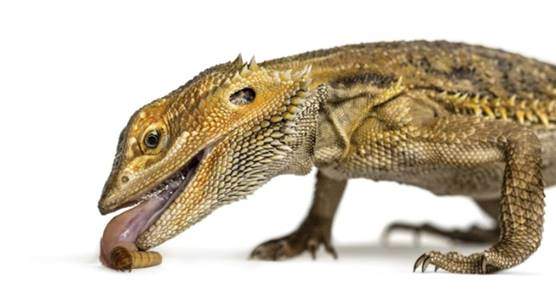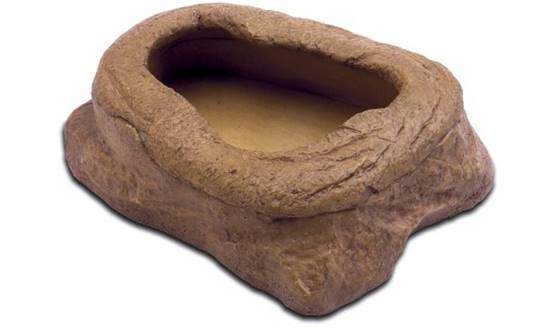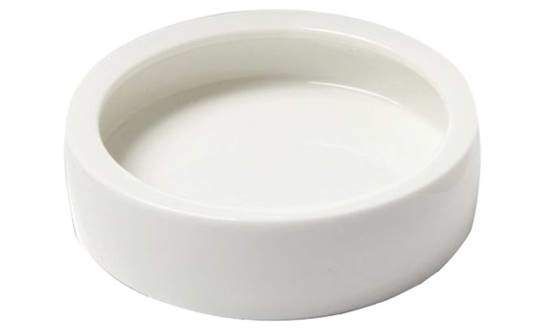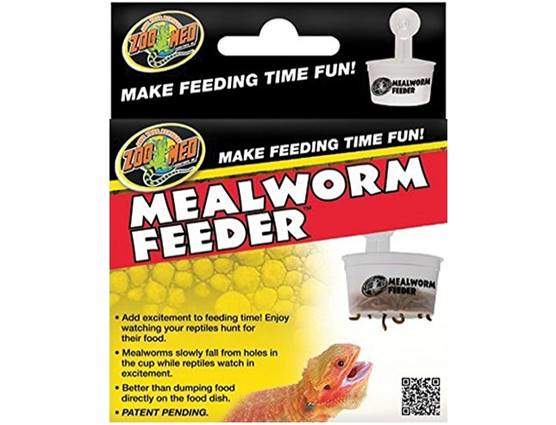Beardies can eat both freeze-dried or canned (dead) and live mealworms. Most beardies will easily recognize live ones since they do move as opposed to the dead ones. If you buy freeze-dried ones, we will give you a few tricks to get these pets to eat them.
If you don’t want to spend much money buying them, you can raise mealworms as it is not a very difficult task
Are mealworms good for bearded dragons?
Yes, they are an excellent feeder insect. However, mealworms should not be given as staple feeder insects but as a supplement or a small part of their diet. Also, beardies can eat pupae or adult beetles occasionally. However, it won’t make any economic sense.

Looking at their nutritional composition below nutritional composition[1], you will agree that they are nutritious.
- Moisture 44%
- Fat 72%
- Protein 27%
- Fiber 73%
- Ash 57%
- Ca, ppm 133
- P, ppm 3345
- Ca:P ratio 1:2.5
Although this data may vary a little bit depending on how you gut load or feed them, you can conclude that they are high in fats than crickets or other staple feeder insects and low in calcium, making them not an ideal staple. Being high in fats, it can increase the chances of hepatic lipidosis and obesity if they eat them every day.
Furthermore, they have a tough shell made of chitin that is hard to digest and may present a risk of impaction primarily if you feed these pets large ones to small beardies such as babies or juveniles.
On the other hand, freeze-dried mealworms will have a similar nutritional composition, with the only variation being the amount of moisture content they have.
Why are they famous?
Mealworms are so popular amongst not just people with beardies but also other reptiles, birds, amphibians, and small mammals because of the following reasons:
- They are cheap to buy – If you consider their price, you will notice that they are quite affordable with 5000 medium size mealworms going for a little as $40 or less.
- Raising and maintaining mealworms is easy and cheap – With a container, a means of keeping their optimum temperature that is between 70-80 degrees Fahrenheit, substrate and a few veggies, they can easily be kept alive or bred.
- They are large – Their large size means that most pets will eat only a few and they are full.
- They live long – If refrigerated, typically at 45-50 degrees Fahrenheit, they will go dormant but not die for several months. All you need to do is let them out for a day or two to eat.
Can baby bearded dragons eat mealworms?
No. Do not feed your hatchlings or baby beardies mealworms. They have a tough exoskeleton, and most sold are about half an inch making them large and very difficult for them to digest, and they may cause impaction, which can put pressure on their spinal cord and even cause death.
Instead, feed them pinhead crickets, small Dubia roaches, wax worms, fruit flies, and other smaller insects or worms that do not have tough exoskeletons. Also, baby beardies can eat commercial diets such as Exo Terra Bearded Dragon Juvenile or Fluker’s Buffet Blend Food for Juvenile Bearded Dragons but on rare occasions.
Secondly, since they are not very nutritious and are high in fats, they might not provide the much-needed nutrients to promote growth in these pets.
Thirdly, in case they eat these larvae accidentally, consider lukewarm baths and belly baths. Also, give them baby food applesauce, pureed pumpkin diluted in water as well as safe dilute fruit juices.
Finally, if you suspect that these baby pets have an impaction and they have pass stool after five days, take them to your veterinarian for further treatment.
Can juvenile bearded dragons eat mealworms
It depends on their size. Any juveniles below the age of six months should not eat mealworms while those at least six months ca eat time.
If of age, give your juvenile beardies both dry and live ones, once or twice in a week. However, avoid big or giant mealies as they may cause impaction.
When giving them these feeder insects, give them younger ones, especially after they have just molted as they tend to have a softer exoskeleton. One or two are enough. The recently molted ones will have a white appearance and not the yellowish or golden color.
To get a rough idea of the correct juvenile bearded dragon mealworms size, they should not be larger than the space between their eyes to avoid any impaction chances.
Finally, they should not be a staple diet, i.e., give them occasionally. Stick to staples such as Dubia roaches, silkworms, crickets, locusts, grasshoppers, black solder larvae, and so on.
How much or many?
How much to give to your bearded dragon will depend on her or her age and size of your grubs. Since they are not a staple diet, they should feed in limited amounts.
For instance, you can give your adult bearded dragon 5-6 mealworms once or twice a week. They are not ideal for daily feeding.
Feeding adult beardies too many of these high-fat live feeders may make them obese, something you do not want to happen.
Live mealworms
Live mealworms are the ideal worms to feed this lizard as they have moisture, are appealing, easy to feed, among other benefits.
You can buy them in small amounts or bulk from your local pet store, from Predator Foods, Fluker’s farm, Walmart, Rainbow Farms, PetSmart, Bassett’s Cricket Ranch, Josh’s Frog, Petco, among many other places.
Before feeding your beardies live mealworms, gut-load them a few days before and when giving them to your pet dust mealworms with calcium, vitamin D3, and other multivitamins.
However, not everyone likes caring for and handling live feeder insects, and they are costly if you keep buying them a reason why they opt for dried ones.
Dead – dry or freeze-dried
Beardies can eat dried mealworms, whether they are dried naturally or freeze-dried ones. They are affordable, have a long shelf-life, need not refrigeration, among other benefits.
Secondly, you need to order the correct side of these worms. Standard sizes sold are ¼ inch to 1 inch, choose a smaller size for your juvenile while for adults, choose a bigger size, depending on their size. You can buy even the giant mealworms that are over 1 inch in length.
If you need them, you can get quality bulk dried mealworms from amazon.com, Walmart, Petco, Wilko, Tractor supply, Lowes.com.
Some great ones include Fluker’s Freeze-Dried Mealworms, TradeKing, Exo Terra, Zilla munchies, Tasty Bug Treats, Hatortempt, among many other brands.
Beardie not eating mealworms
If your beardie is not eating, it could be poor terrarium conditions such as low temperature, it is sick, shedding, impacted, has stress, parasites, and other reasons. Also, brumation, and so on may be a cause.
Try offering them other feeder crickets, silkworms, butterworms, cockroaches, and so on. If they still don’t eat them, notify your herp vet.
However, if it does not eat only the dried ones, try hand feeding, using a tong such as the Zoo Med Super Deluxe Stainless Steel Feeding Tongs, hide them in veggies, or use a vibrating bowl. The Exo Terra Vivicator Vibrating Feeding Dish is one such vibrating bowl.
Best bearded dragon mealworm feeders and dishes
When feeding these feeder insects to this reptile, if they are dry, you can use their regular feeding bowls. However, if they are alive, you need something that will prevent them from crawling away. Some great feeders include
1. Exo-Terra Reptile Mealworm Feeder Worm Dish
This feeding dish will blend well with your vivarium décor, is easy to access and safe since the resins used are food grade. Furthermore, it is smooth and has a non-porous surface that will ensure it is easy to clean, and there are no bacteria absorbed.
Another reason why you need this bowl and not just any other is owing to is edge ring designed in a way that your worms will not escape.

2. SLSON Reptile Feed Feeder or Water Ceramics Bowl
This multipurpose, durable ceramic bowl is another great worm feeder you should buy. It is safe, easy to clean, or disinfect since it has a smooth surface. Furthermore, this worm feeder is shallow, making it easy for your beardie to reach their food.
Its inner surface slightly curves inwards to make it impossible for worms to crawl out of it, and you can use it for not just bearded dragons but also your gecko, snake, chameleons, iguana, corn snake as well as others.
Finally, it is ideal for providing drinking water or feeding mealworms, cockroach larvae, and other feeder insects that these pets eat.

3. Zoo Med Hanging Mealworm Feeder
Finally, you can try this Zoo Med Hanging, which you can install easily, and it will encourage the natural hunting behaviors. Worms will be falling through its hole and down to a bowl, or your pets may pick and eat them up.
While some people find it a great feeder, others find its holes tiny and cannot allow bigger worms, including superworms and waxworms, to pass through.

Myths
Forget about the common myth that these worms will eat these pets intestines or be excreted undigested.
Conclusion
Mealworms are not bad for beardies if fed as an occasional meal or a small part of their diet.
